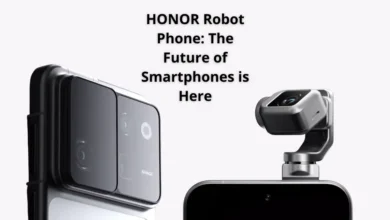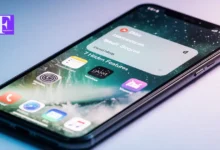Discover the AI-Powered Smartphones of 2025

The global AI smartphone market is on the verge of a big leap. It’s expected to grow from USD 90.8 billion in 2025 to USD 854.2 billion by 2034. This rapid expansion shows how crucial artificial intelligence is becoming in mobile tech.
As we get closer to 2025, makers are working hard to add AI to their devices. They want to make the user experience better. The future of mobile tech is being shaped by AI, better cameras, and faster processors.
The year 2025 is set to be a major milestone for AI-driven smartphones. We can expect big changes in how devices work and interact with us.
Key Takeaways
- The AI smartphone market is expected to experience rapid growth.
- Advancements in AI will enhance user experience.
- Major manufacturers are integrating AI into their products.
- Camera capabilities and processing power are also expected to improve.
- 2025 is a significant year for the future of mobile technology.
The Evolution of Smartphone Intelligence
Smartphones have grown smarter over time. They’ve moved from simple voice assistants to advanced AI friends. Now, they can understand and guess what we need.
From Basic Assistants to AI Companions
The journey started with basic voice assistants. These early tools were just the beginning. They paved the way for more advanced AI features.
Key Milestones in Smartphone AI Development
AI in smartphones has seen major milestones:
Early Voice Assistants (2011-2015)
- Siri, Google Now, and Cortana were introduced.
- They could only handle voice commands at first.
- They took the first steps towards understanding language.
On-Device AI Processing (2016-2020)
- AI processing moved from the cloud to the phone.
- Apple’s Neural Engine was a big step forward.
- AI tasks became faster and more efficient.
Generative AI Integration (2021-2024)
- Generative AI models got a lot better.
- AI helped make photos better, improving camera skills.
- Smartphones got even more personal and predictive.
Smartphones have changed a lot. They’ve gone from simple voice assistants to smart AI friends. As AI keeps getting better, we’ll see even more cool features in phones soon.
Understanding AI-Powered Smartphones 2025
As we get closer to 2025, smartphones are about to change a lot with AI. The Samsung Galaxy S25 Ultra and Apple iPhone 17 Pro will lead the way. They are expected to be the top AI smartphones in 2025.
Definition and Core Technologies
AI smartphones in 2025 will have better AI, more power, and improved cameras. They will use neural processing units (NPUs), AI software, and advanced sensors. These features will make the phones more personal and efficient for users.
How 2025 Models Differ from Current Generations
The 2025 models will be much better than today’s phones. They will have more power and better AI. Two main areas they will improve are:
Processing Power Comparisons
New smartphones will have much more powerful processing. They will have more efficient NPUs for handling AI tasks. For example, the Apple iPhone 17 Pro will have a top-notch NPU for better AI.
AI Capability Benchmarks
AI benchmarks will also get better. This will help compare phones more accurately. Benchmarks will check how well phones do AI tasks like recognizing images and understanding language.
These upgrades mean AI smartphones in 2025 will have cutting-edge features. They will change how we use our phones. AI will make interfaces smarter, security better, and experiences more personal.
Read Also :
Android 15 Supported Devices — Full List for 2025
Revolutionary Hardware Powering AI Smartphones
As we look towards 2025, AI smartphones are getting a major upgrade. New components are making them faster, more efficient, and better for users.
Next-Generation Neural Processing Units
The heart of AI smartphones is the Neural Processing Unit (NPU). By 2025, NPUs will be much more advanced. The Google Tensor G5 and Apple A19 Pro chips are leading the way.
These chips make AI tasks run faster and use less power. This means better performance and longer battery life for users.
Quantum Computing Elements in Mobile Devices
Quantum computing is coming to mobile devices. It could make them much more powerful. Though still new, it could change how AI smartphones solve complex problems.
Advanced Battery Technologies for AI Workloads
AI workloads need better batteries. In 2025, AI smartphones will use new battery techs. This includes solid-state batteries and energy harvesting.
Solid-State Battery Implementation
Solid-state batteries are a big deal. They pack more energy, charge faster, and are safer than old batteries. This is great for AI smartphones, which need reliable power.
Energy Harvesting Technologies
AI smartphones are also getting solar charging and kinetic energy recovery. These features help charge the phone in new ways. They also make the phone last longer and are better for the environment.
| Hardware Component | 2025 Innovations | Benefits |
|---|---|---|
| Neural Processing Units | Google Tensor G5, Apple A19 Pro | Enhanced AI processing, improved performance |
| Battery Technologies | Solid-State Batteries, Energy Harvesting | Longer battery life, faster charging, improved safety |
| Computing Elements | Quantum Computing Integration | Exponential increase in processing power |
Breakthrough AI Features Coming to 2025 Smartphones
Smartphones are getting smarter with new AI features in 2025. These advancements are changing how we use our phones. They bring features we never thought possible.
Predictive User Experience Adaptation
One cool feature is predictive user experience adaptation. It lets phones learn and guess what you need. For example, your phone might save battery when you’re about to run out.
Real-Time Language Processing and Translation
AI is making language barriers disappear. Smartphones in 2025 will translate languages instantly. This makes talking to people from other countries easier than ever.
Advanced Spatial Computing Capabilities
Another big change is in spatial computing. This includes holographic interfaces and gesture recognition. It’s changing how we use our phones.
Holographic Interfaces
Holographic displays are changing how we see information. The Samsung Galaxy S25 Ultra shows this with its advanced spatial computing. You can interact with 3D images, making work and play more fun.
Gesture Recognition Systems
Gesture recognition is getting better too. It lets you control your phone with gestures. This makes using your phone feel more natural.
| Feature | Description | Benefit |
|---|---|---|
| Predictive User Experience | AI adapts to user behavior | Enhanced user experience |
| Real-Time Translation | Instant language translation | Global communication |
| Holographic Interfaces | 3D image interaction | Immersive experience |
| Gesture Recognition | Intuitive device control | Natural interaction |
The AI features in 2025 smartphones are going to change everything. They will make your phone more personal, interactive, and fun. Get ready for a new way of using your phone.
Transforming User Interfaces Through AI
The AI-powered smartphones of 2025 are changing how we use them. They are becoming more intuitive and personalized. This makes our experience with them better.
Beyond Touch: Mind and Gesture Controls
One big change is mind and gesture controls. These let us use our phones without touching them. We can use our brain signals or hand gestures to control them.
This is great for people with disabilities. It makes phones easier to use for them. For example, you can think about calling someone, and the phone will do it for you.
Adaptive Interfaces That Learn User Preferences
AI smartphones in 2025 also have adaptive interfaces. These learn and change based on how we use them. They can change the layout, suggest apps, and adjust settings for us.
This makes our phones more personal and efficient.For example, the Apple iPhone 17 Pro learns our preferences for a better experience.
“The future of smartphones lies in their ability to understand and adapt to the user’s needs, making the interaction more natural and intuitive.”
Ambient Computing Integration
Ambient computing is another key feature. It makes our phones part of our environment. This gives us a more connected experience.
Contextual Awareness Systems
Contextual awareness systems help our phones understand us better. They know where we are, what we’re doing, and how we feel. This lets them give us the right information at the right time.
For example, if you’re on your way to work, your phone might suggest the best route. This makes our phones more helpful and connected to our lives.
In conclusion, AI is changing how we use our smartphones. With features like mind and gesture controls, adaptive interfaces, and ambient computing, our phones are getting smarter and more personal. They are becoming an essential part of our daily lives.
Apple’s AI Vision: iPhone 17 Pro and Beyond
The iPhone 17 Pro is set to change the smartphone world with its AI features. It will make using the phone better with its smart AI tech. This is a big step for Apple in using AI in its products.
Apple Intelligence 3.0 Ecosystem
The iPhone 17 Pro has Apple Intelligence 3.0, a smart AI system. It makes using the phone easier and more personal. It learns what you like and gets better over time.
Hardware Innovations in the iPhone 17 Series
The iPhone 17 Series brings new hardware that works well with AI. It has faster neural processing units and better cameras. These help the phone do complex AI tasks.
Integration with Apple’s Extended Reality Platform
The iPhone 17 Pro also works with Apple’s Extended Reality (XR) platform. This makes using the phone more fun and interactive. It opens up new ways to play, learn, and more.
Apple Vision Pro 2 Connectivity
One cool thing is how it connects with the Apple Vision Pro 2. You can start something on one device and pick it up on another. This makes using Apple products even better.
In short, the iPhone 17 Pro is a big leap in AI smartphones. It combines top-notch hardware with smart AI. Apple is always finding new ways to make our experiences better with AI.
Samsung’s AI Revolution: Galaxy S35 and Z Fold 7
Samsung’s latest phones, the Galaxy S35 and Z Fold 7, are at the forefront of AI in smartphones. They show Samsung’s dedication to improving AI in mobile tech.
AI Ecosystem in 2025
In 2025, Samsung’s AI ecosystem will grow, with the Galaxy S35 and Z Fold 7 leading the way. The company aims to make user experiences smoother and more intuitive with advanced AI.
The Galaxy S35 has a AI-powered camera system. Meanwhile, the Z Fold 7 has a flexible display with AI-driven interface adaptations.
Flexible Display Innovations with AI Enhancement
The Samsung Galaxy S25 Ultra has a flexible display with AI enhancement. This allows for more dynamic and versatile user interactions. The device can change its interface based on how you use it.
Galaxy AI Assistant Evolution
The Galaxy AI assistant is getting better at giving users personalized experiences. This is thanks to big leaps in AI technology.
Bixby’s Transformation into a Full Neural Assistant
Bixby, Samsung’s AI assistant, is becoming a full neural assistant. This means Bixby can offer more personalized and proactive assistance. It learns from your habits and adapts to your needs.
As Samsung keeps exploring AI in mobile devices, the Galaxy S35 and Z Fold 7 will change the smartphone world in 2025.
Google’s AI Mastery: Pixel 10 and Pixel Fold 3
Google is set to show off its AI skills with the Pixel 10 and Pixel Fold 3. These phones will use advanced AI models, like Google’s Gemini AI. This will make using the phones smarter and more natural.
Advanced AI Models on Mobile
The Pixel 10 series will use Google’s latest AI tech for a more personal experience. AI models like Gemini will help with things like predictive maintenance and better camera shots. They will also improve security.
Key Features of Google’s Advanced AI Models:
- Enhanced predictive capabilities
- Advanced image processing
- Personalized user experience
Computational Photography Breakthroughs
Google has always been at the forefront of smartphone photography. The Pixel 10 and Pixel Fold 3 will keep this trend going. They will have better photos, new photo modes, and improved video recording.
Android AI Integration in 2025
The Pixel 10 series will run on Android 18, made with AI in mind. This will make AI features work smoothly across the device. It will improve how the phone works and how you interact with it.
Android 18’s AI-First Approach
Android 18 is all about making the most of AI in phones. It has cool features like real-time language translation and advanced health monitoring. It also manages your battery better, making it a big step up from before.
| Feature | Description | Benefit |
|---|---|---|
| Real-Time Language Translation | Translates languages in real-time | Enhanced communication |
| Advanced Health Monitoring | Monitors health metrics | Proactive health management |
| Intelligent Battery Management | Optimizes battery life | Longer device usage |
The Pixel 10 and Pixel Fold 3 are a big step up in AI phones. They offer a smarter, more natural, and more integrated experience for users.
Chinese Manufacturers Leading AI Innovation
Chinese tech companies are changing the smartphone world with new AI features in 2025. They are using advanced AI technology to make phones better for users. This is setting new standards for the industry.
Xiaomi’s AI Advancements in the Mi 16 Series
Xiaomi’s Mi 16 Series is leading in AI innovation. It has advanced AI camera features, better AI performance, and stronger AI security. The AI in the Mi 16 Series makes the phone more personal, fitting your needs and habits.
Key AI Features in Xiaomi Mi 16 Series:
- AI-driven camera with enhanced image processing
- AI-powered performance optimization
- Advanced AI-based security features
OPPO and OnePlus AI Integration
OPPO and OnePlus are also pushing AI forward. They focus on making phones better with AI features. Their latest phones have better cameras, longer battery life, and more personalized interfaces thanks to AI.
Huawei’s Comeback with HarmonyOS AI
Huawei is back with HarmonyOS AI, offering a seamless AI experience. HarmonyOS AI makes devices more intuitive and personal. It uses AI to understand and meet user needs.
Vivo and Realme’s Competitive AI Features
Vivo and Realme are also introducing AI features in their phones. These include better cameras, improved performance, and new interfaces. They aim to compete in the AI smartphone market.
The AI smartphone market in 2025 is all about fast innovation and better user experiences. Here’s a table showing the main AI features of Chinese manufacturers:
| Manufacturer | Model Series | Key AI Features |
|---|---|---|
| Xiaomi | Mi 16 Series | AI-driven camera, AI-powered performance |
| OPPO | Find Series | AI-enhanced camera, AI-powered battery life |
| OnePlus | OnePlus 11 Series | AI-driven performance, AI-powered interfaces |
| Huawei | P50 Series | HarmonyOS AI, AI-enhanced security |
| Vivo | Vivo X80 Series | AI-enhanced camera, AI-driven performance |
| Realme | Realme GT Series | AI-powered performance, AI-driven interfaces |

Emerging Players in the AI-Powered Smartphones 2025 Market
New companies are shaking up the AI smartphone market. They’re introducing fresh ideas in AI, design, and how we use phones. This could shake things up for big brands.
Nothing Phone 5: Minimalist AI Approach
The Nothing Phone 5 takes a minimalist AI approach. It focuses on being simple and easy to use. The goal is to make AI features that don’t confuse users.
Startup Innovations Challenging Established Brands
Startups like Framework and Neural Link are changing the game. They’re bringing new tech to the AI smartphone world.
Framework’s Modular AI Smartphone
Framework’s phone is all about modularity. You can upgrade parts, not the whole phone. This cuts down on waste and keeps your phone up-to-date.
Neural Link’s Brain-Computer Interface Phone
Neural Link is working on a Brain-Computer Interface (BCI) Phone. It lets you control your phone with your mind. This could change how we use our phones forever.
These new players are bringing exciting tech and fresh ideas. As the market grows, we’ll see more phones that meet different needs and tastes.
AI-Driven Camera Systems of 2025
In 2025, smartphones with AI cameras will change how we take photos. They use artificial intelligence to improve mobile photography.
Computational Photography Beyond Pixels
Computational photography has grown beyond just capturing pixels. Now, it uses AI to make images better, reduce noise, and offer cool features like advanced portrait and night mode. For example, the Samsung Galaxy S25 Ultra has a camera system that takes amazing photos in any light.
Key Features of Computational Photography:
- Advanced image processing algorithms
- Enhanced low-light photography
- Improved portrait mode with depth sensing
Video Enhancement Through Real-Time AI
AI camera systems in 2025 smartphones also improve video recording. Real-time AI processing adds features like video stabilization and automatic object tracking. This makes it easy to record high-quality videos.
The benefits of real-time AI in video enhancement include:
- Smoother video playback
- Improved color grading
- Enhanced object detection
AR Integration with Camera Systems
Augmented Reality (AR) is a big part of AI camera systems in 2025. AR lets users interact with their world in new ways, like virtual try-on and interactive filters.
3D Scene Understanding and Reconstruction
AR works thanks to 3D scene understanding and reconstruction. AI algorithms can now map and understand our surroundings. This makes AR experiences more realistic and interactive.
Advantages of 3D Scene Understanding:
- More accurate AR mapping
- Enhanced user interaction
- Improved AR filter accuracy
Privacy, Security, and Ethics in AI Smartphones
The tech world is facing a big challenge with AI smartphones in 2025. It’s all about finding a balance between new tech and keeping user data safe. As these devices play a bigger role in our lives, protecting privacy and security is more important than ever.
On-Device AI Processing for Enhanced Privacy
One key feature of AI smartphones is on-device processing. This keeps data on your phone, not in the cloud. For example, Apple uses on-device AI to keep your info safe from hackers.
Biometric Security Advancements
AI smartphones are also getting better at biometric security. Features like facial recognition and fingerprint scanning are getting smarter. This means you get more security and convenience.
Ethical Considerations in AI Data Collection
How AI smartphones collect and use data is a big ethical issue. Companies must find a way to offer personalized services without invading your privacy.
Regulatory Frameworks for AI in Personal Devices
New rules are being made to control AI in personal devices. These rules aim to make sure AI is used right and keeps your data safe.
User Control Over AI Systems
It’s key for users to have control over their AI systems. This means knowing how your data is used and being able to choose what features you want. This way, you can protect your personal info.

In summary, as AI smartphones grow, it’s vital for makers to focus on privacy, security, and ethics. By using on-device AI, improving biometric security, and letting users control their data, the tech world can earn back trust. This will lead to a safer future for mobile tech.
Health and Wellness Features Powered by AI
In 2025, AI smartphones will change how we manage our health. They will offer advanced health monitoring. This makes health care more personal and proactive.
Advanced Health Monitoring Capabilities
AI smartphones can now track many health metrics. This includes heart rate, blood oxygen levels, and even ECG readings.
Key Features:
- Continuous health monitoring
- Advanced biometric tracking
- Personalized health insights
Preventative Health Insights Through AI
AI analyzes health data to give insights. This helps users spot health issues early.
The predictive power of AI in health monitoring is a big step towards preventive care.
Integration with Medical Systems and Wearables
AI smartphones connect with medical systems and wearables. This gives a full view of a user’s health.
| Feature | Description | Benefit |
|---|---|---|
| Health Data Sync | Syncs health data across devices | Comprehensive health overview |
| Wearable Integration | Integrates with wearables for continuous monitoring | Enhanced health tracking |
| Medical System Connectivity | Shares data with medical professionals | Informed medical decisions |
FDA-Approved Diagnostic Features
Some AI smartphones in 2025 will have FDA-approved features. These allow users to do medical-grade diagnostics on their phones.
The future of health and wellness is shaped by AI smartphones. As these technologies grow, we’ll see more health monitoring features.
The Environmental Impact of AI Smartphones
AI smartphones in 2025 are changing how we think about the environment. These devices are getting smarter, but they’re also making a bigger impact on our planet. This is why companies are working hard to make them more eco-friendly.
Sustainable Manufacturing Practices
Big names like Samsung are leading the way with sustainable manufacturing practices. They’re cutting down on waste and using less energy. Samsung, for example, has set up special production lines that are kinder to the environment.
Energy Efficiency Improvements
AI smartphones are getting better at saving energy. Thanks to new tech, they use less power but still perform well. This is good for the planet and means your phone lasts longer.
Recycling and Circular Economy Initiatives
The industry is also focusing on recycling and circular economy initiatives. Phones are being made to be recycled more easily. There are programs to get old phones back, too. This cuts down on waste and saves resources.
Carbon Footprint Reduction Strategies
Companies are also working on carbon footprint reduction strategies. They’re using green energy, improving delivery routes, and making products that can be recycled. Experts say this is key for the tech industry’s future.
By taking these steps, the smartphone world can lessen its environmental impact. This will help make mobile tech more sustainable for years to come.
Conclusion: The Future Beyond 2025
The year 2025 is a big step for ai-powered smartphones. We’ve seen big leaps in AI, camera tech, and how fast they can process things. Looking ahead, new tech will keep changing how we use our phones.
New smartphones will bring together 5G and AI. This means faster data, better security, and a smoother experience for users. As these phones get smarter, we’ll see cool stuff like better augmented reality, health tracking, and personal help.
Future phones will learn and change based on what we like. This means they’ll get even better at understanding us. With constant innovation, we’ll see new ways to use our phones, making them even more useful and fun.
FAQ
What are the key features of AI-powered smartphones in 2025?
How do AI-powered smartphones differ from current generations?
What is the role of neural processing units in AI smartphones?
How will AI-powered smartphones impact user interfaces?
What are the privacy and security concerns associated with AI smartphones?
How will AI-powered smartphones be used for health and wellness?
What are the environmental implications of AI smartphones?
What can we expect from AI-powered smartphones beyond 2025?
How are Chinese manufacturers contributing to AI innovation in smartphones?
What are the emerging trends in AI-driven camera systems?
Discover more from Feenanoor
Subscribe to get the latest posts sent to your email.









